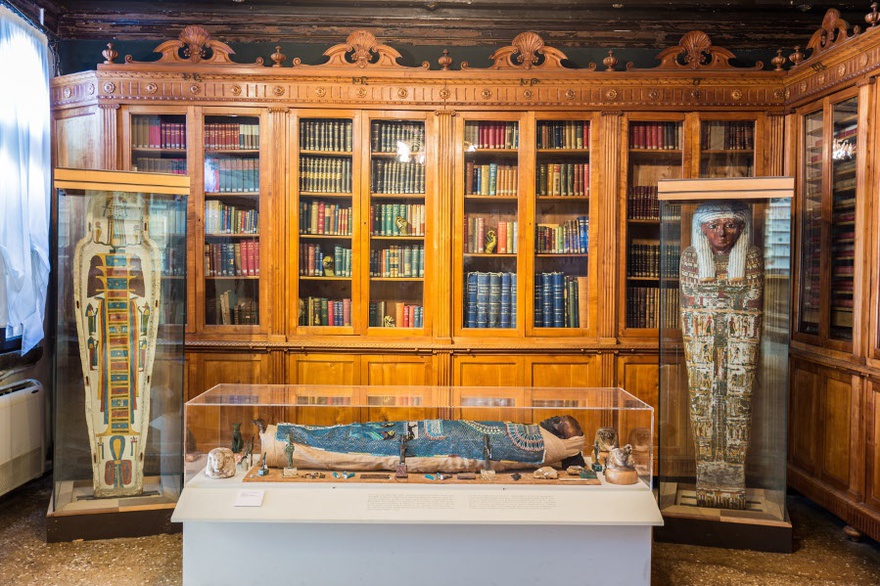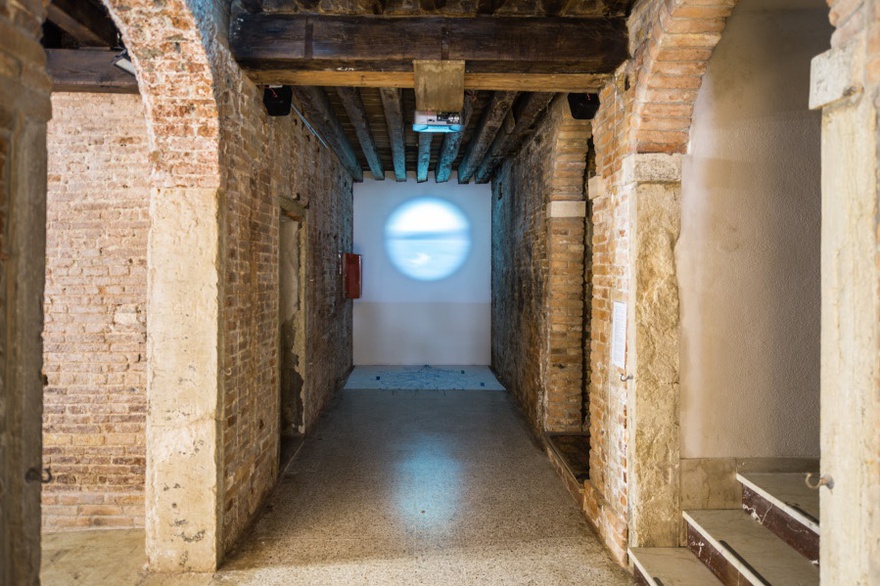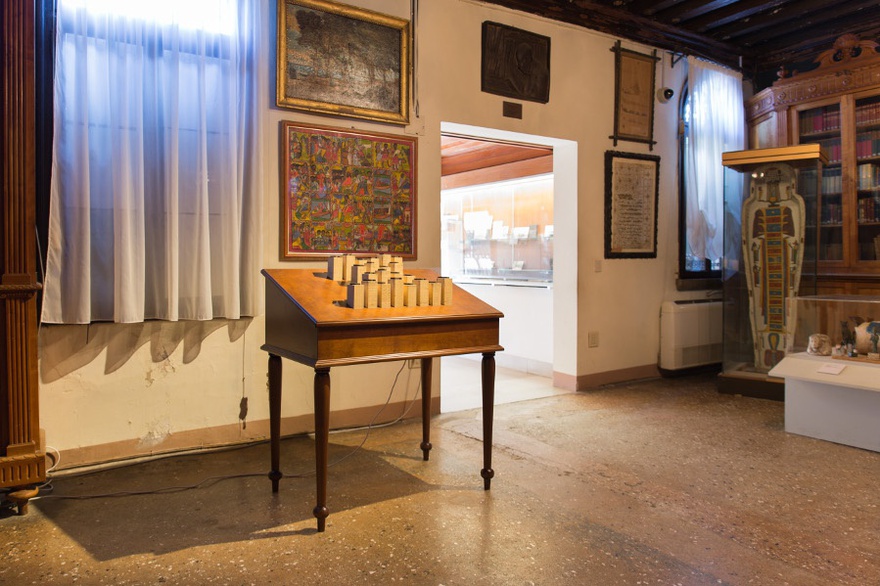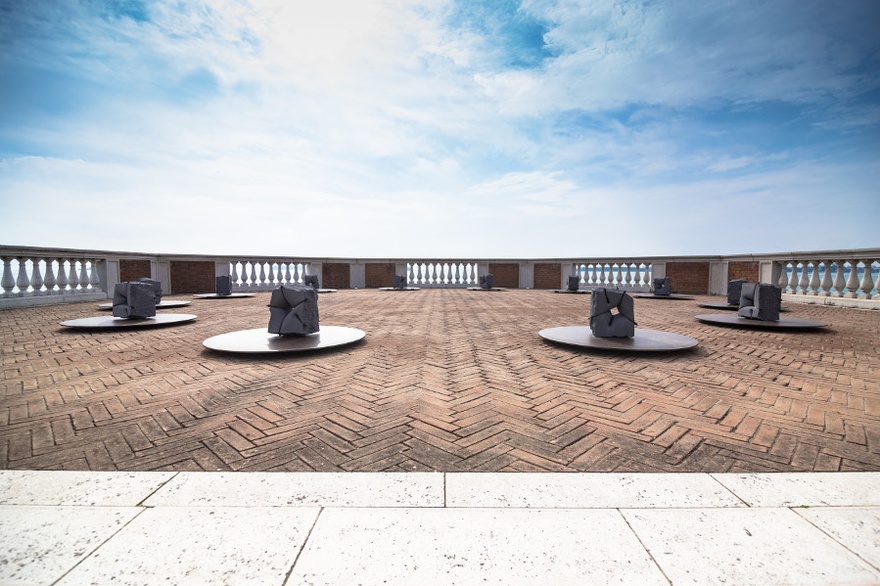Essays
Transition Times
Performing Armenity at the 56th Venice Biennale
In this essay, written for the Golden Lion award-winning Pavilion of Armenia at the 56th Venice Biennale (2015) curated by Adelina Cüberyan von Fürstenberg, Stephanie Bailey considers the Pavilion's curatorial proposition of a transnational assembly. This text expands on questions explored in an essay for The Jerusalem Show VII: Fractures (2014), published on Ibraaz in 2014.
I am not ashamed of my identity, it is still under construction.
Mahmoud Darwish
There are so many crosses for us to bear, these days: so much that weighs down on us as individuals, communities, and nations. The twenty-first century has only just begun, and the clash between the past and the future is already underway. From nationalism to post-nationalism to a kind of neo-nationalism, the very foundations with which we identify as citizens are being re-negotiated. Take the battle between Israel and Palestine – an instance of a nation maintaining its statehood, and a nation asserting its right to statehood, respectively; or the conditions in Europe, where a kind of post-nationalist unification has produced a rise in neo-nationalism. Then we have ISIS: what The New Scientist has described as hypermodern, 'more of a network than a nation',[1] which has declared war on, amongst other things, the 1916 Sykes-Picot agreement that carved up the Middle East into British and French 'spheres of influence.'[2] And on the flip side, there is democratic confederalism – a political approach that aims to escape, as Abdullah Ocalan explains, 'the trap of nationalism' by offering a 'non-state social paradigm.'[3]
More and more, we are witnessing the world as a historical, geopolitical mesh of rampant and often volatile negotiation: there is as much to untangle as there is to assert. We have so much to deal with, and yet so little time to take it all in. Lessons are not learned, wounds of the past are festering, and healing feels as remote as the stories that define who we are because so much has been forgotten, and even denied. Take the Armenian Genocide: an event that Raphael Lemkin used as an example for a term he coined to describe what Churchill called, during the Nazi purges, 'a crime without a name.'[4]
It is no coincidence that the Armenians call their genocide aghet, which means catastrophe: the same meaning of the word the Palestinians use to remember the loss of their homeland, al-Nakba. Nor is it chance that the Nazis returned the remains of Talaat Pasha – one of the key architects of the Armenian Genocide – to Turkey in 1943 (Turkey was allied with Germany in World War I). These catastrophes took place during the two world wars that defined a violent century in which, as Mark Levene observed in 2000, a global system of nation states came into full fruition.[5] On the study of genocide, Levene insists on understanding the phenomenon through an investigation not only of the historical context of each individual genocide, but also 'the macro-historical record' – 'the broad and moving canvas in which we might chart and hopefully analyse the emergence and development of the current international system.'[6]
But as individuals, how do we navigate this contested space of world history in the new twenty-first century? There is no map – no beginning or end: not one single starting point. There is just relation, for better or for worse; and histories – an infinite number of them. We can see these histories unfolding in such spaces as the World Wide Web – a place where the distances between people and places are collapsed with the click of a button, and where the world is – quite literally – at our fingertips. As our contemporary Library of Alexandria, the Internet is a networked space where individuals, communities, nations, regions, and worlds co-mingle, existing autonomously, or atomically, in such a way that recalls Muriel Rukeyser 's observation that the universe is made of stories, not atoms.
The vastness and complexity of our historical world is palpable, too, in such events as the Venice Biennale; an event with its roots in the National and World's Fairs of the eighteenth and nineteenth centuries, and which evolved in 1895 – at the turn of the twenieth century – into an international exhibition of art and culture organized according to national pavilions so as to offer a worldview once every two years. As Lawrence Alloway wrote, the Venice Biennale is a 'a big exhibition' that represents 'a compressed journey…taken by the exhibition visitor in a single day.'[7] And the journey just keeps getting longer and more complicated. Even in 1968, Alloway observed how unprecedented quantity and multiplicity was rendering art an uncontrollable subject: 'Its boundaries are no longer clear; its scale is no longer compact. This holds true, also, for the past, which obviously is steadily increasing as a result of the passage of time, and ever-more-sophisticated techniques of inquiry into the periods.'[8]
Ultimately, when faced with the ever-lengthening scroll of human history as represented in such world spaces as the Venice Biennale, it is down to the individual to take what they can from what they see and understand. After all, as Paul Crowther noted in Art and Embodiment, 'the structure of embodied subjectivity and of the world are directly correlated.'[9] Thus, when entering spaces like these, you might say we all become global wanderers, as we move from webpage to webpage, or from national pavilion to collateral event. We become bodies that exist between frames, like those of the displaced: bodies that relate to the world – and to each other – through personal experience first and foremost.
This is where Armenity comes in: a pavilion that is dedicated to artists of the Armenian diaspora. Or more specifically, the grandchildren of survivors of the Armenian Genocide, who were born all over the world, from Beirut to Lyon and Los Angeles to Cairo, and whose 'concerns transcend notions of territory, borders and geography, precisely because this is their legacy, heritage and birthright.' They are, like so many other paradigmatic diasporas, the embodiment of what Arjun Appadurai has called one of the crucibles of an emergent post-national order: a diasporic public sphere that is established and maintained through international migration and the transnational mediation of national ethnicities that operates beyond the confines of a single nation-state.[10] The artists included in this exhibition are global citizens of the twenty-first century. They are proposed here as a 'transnational assembly' intimately connected with the history that brought them into being. Their birthright is to mediate systems that do not reflect their own particular state of existence. Think about the Kurds, for instance: a nation that exists 'mostly within the present-day borders of Turkey, Iraq and Iran, with smaller parts in Syria, Armenia and Azerbaijan.'[11]
It is this precise condition: a nation that is at once confined by its borders as much as its borders are dissolved by its diaspora, that gives this exhibition a vision of what Greek-Armenian artist Aikaterini Gegisian describes as 'utopic potential'. For the artists showing in Armenity, it is the individual who draws the map; the artists who become the new cartographers charting a future that has not quite taken shape. Take Rosana Palazyan's video installation, "…A story I never forgot…" (2013–15), which traces Palazyan's grandmother's journey from Thessaloniki to Rio de Janeiro: a legacy the artist decided to confront when she was invited to show at the 4th Thessaloniki Biennale in 2013–14, as a kind of homecoming. Here, remembrance becomes a tracing of a self that is rooted in a violent displacement: a history that has been passed down as a personal, albeit collective, recall. In Palazyan's tracing is the assertion of a continuation: a demonstration that a journey, which started in 1915 and has lead to all points of the globe, has not ended. After all, as she the artist writes: 'to forget [the Armenian Genocide] would mean forgetting one's own being.'[12]
Palazyan's project positions the artist as a cartographic 'chronicler'. What Walter Benjamin described as one 'who recounts events without distinguishing between the great and small', and in doing so 'accounts for the truth, that nothing which has ever happened is to be given as lost to history.' The chronicler uncovers a past worthy of a 'resurrected humanity.'[13] A role that recalls that of the artist as articulated through Nigol Bezjian's effective study into the life and work of the poet Daniel Varoujan in Poet/Mourner (2013). In this 20-minute video, Bezjian presents an edited version of a lecture by associate professor of the department of Armenian studies at Columbia University, Marc Nichanian, on Varoujan, one of the first Armenian intellectuals to be arrested by the Young Turks in 1915. In his lecture, Nichanian presents three poems by Varoujan – 'Vahakn', 'Among the Ruins of Ani', and 'To the Cilician Ashes' – so as to explain the position of the poet as a mourner: one left to pick up the pieces after a massacre. But the poet in this proposition is not the Angel of History pushed forward by progress, never able to make whole the pile of wreckage which makes up history's wake. Rather, the poet is a chronicler: one who 'sees one single catastrophe which keeps piling wreckage' and stays to 'awaken the dead, and make whole what has been smashed.'[14] This is the recuperative effort of recalling, reviving, and illuminating a history that was so savagely forged, and which is woven into the fabric of the world through the bodies that represent it. Our histories walk among us.
Consider Haig Aivazian's research into the life of Turkish-Armenian oud master Udi Hrant Kenkulian: a project that reflects on the life of a musician who traveled the world, sharing his craft, by producing a sculpture that considers the modal structures in Ottoman and post-Ottoman music. The sculpture Aivazian presents here, Hastayım Yasıyorum (I Am Sick, But I Am Alive) (2014) is constructed to formally express what Aivazian calls the 'oppositions and entanglements inherent in terms such as Makam and Taksim, simultaneously embodying an irreconcilable coming together and a partitioning.' For him, it is a work that ultimately considers the 'migratory motifs of an Armenian, and the manner in which the resonances of these motifs may be historicized or silenced.' Here, the act of tracing produces an ever more complex constellation of meaning. With the dispersal of the Armenian diaspora comes an even richer intermingling of culture with culture, which brings us back to the transnational order this exhibition proposes through its artists.
As James Tatum observed of Elaine Scarry's The Body in Pain, 'the wounds and deaths in wars denationalize us, reducing us to a fundamental, stateless human identity.'[15] For Scarry, 'the "unmaking" of the human being, the emptying of the nation from his body, is equally characteristic of dying or being wounded, for the in part naturally "given" and in part "made" body is deconstructed.'[16] In this process of 'unmaking', Scarry notes, an 'unmaking of the civilization as it resides in each of those bodies' occurs, too.[17] You might call it an unraveling.
Take Hera Büyüktaşçıyan's sculpture Letters from Lost Paradise (2015), for example, which maps out a journey of language through Lord Byron's time studying Armenian on the island where this exhibition takes place: San Lazzaro degli Armeni, established in the eighteenth century when the Mekhitarian community was expelled from the Peloponnese. Büyüktaşçıyan's sculpture – which presents moving letter stamps spelling out English text written with Armenian script – reflects on what the artist describes as a tension that 'exists between the process of reaching out to understand the other, and the process of becoming totally assimilated and thus alienated from one's own identity, culture and language.' On the work's composition, Büyüktaşçıyan considered the use of the Armenian alphabet in Anatolia in both the past and present day, where some Armenian communities produce texts in Turkish written in Armenian letters.
The work touches on the way Armenian culture has been at once disseminated, assimilated, modified, and contained within such cultural strongholds as San Lazzaro: widely-known to be a focal point for Armenian culture. Indeed, in 1913, Daniel Varoujan wrote in a letter to Garegin Levonian: 'Tread softly on the island consecrated by the Mekhitarist Fathers, each step could be on the ashes of a genius.'[18] The island was also home to the longest running Armenian printing house, established as part of the Mekhitarist Monastery complex, which ran from 1789 to the early 2000s. It was this house that printed Lord Byron's Armenian Exercises and Poetry in 1870, and it is from this house that Büyüktaşçıyan unwinds a history that expands into the world. By relating to the history of the printing press on San Lazzaro, Büyüktaşçıyan produces a connection to the history of the Armenian press in general, which goes back to the end of the eighteenth century, to the communities of the Armenian diaspora.[19] The first newspaper, Azdarar (The Herald) was printed in Madras, India, between 1794 and 1796, while another, Taregrutian (The Chronicle), was launched in 1799 right here on the island of San Lazzaro, printed by the Mekhitarian monks in the modern Western Armenian language, Ashkhararabar. Indeed, by the beginning of the nineteenth century, Marc Grigorian notes, 'Armenian communities as far apart as Bombay and Calcutta in India, Astrakhan in Russia, Vienna in Austria, and Constantinople and Smyrna in the Ottoman Empire, were all enjoying the opportunity to read locally produced newspapers in their native Armenian language.'[20]
The dissemination of Armenian culture in this history reflects on the dissemination of Armenian bodies, too, through the movement of the Armenian diaspora. This recalls a trope in Büyüktaşçıyan's practice in which water is treated as a material metaphor for the traces of memory and history that exist all around us. Take a project the artist recently presented as part of the Jerusalem Show VII, The Recovery of an Early Water (2014), in which the artist used fabric to re-imagine one of Jerusalem's lost water supplies, Hezekiah's Pool: a reservoir that was built during the reign of King Hezekiah, and which has been dry since 2010. Both projects are about fluidity; a visualization of a state of flux, in which movement and change both express the simple fact that we are all connected, one way or another, whether we know it or not, by the histories that have brought us to the present day.
In this state of flow, the body becomes a mediator of the unexpected, the unforeseen, and the uncontrollable: it is always in the process of a certain unraveling and rewinding. As Paul Crowther wrote, the human subject 'is just one amongst other such sensible beings and things, with whom and which it is engaged in a constant process of reciprocal interaction and modification. The reason why this process is constant is because embodied beings are finite. This means that no matter how thoroughly they engage with the sensible world – with Otherness (in the broad sense of both other beings and things) – they cannot fix it into absolute, unchanging place.'[21] Consider Nina Katchadourian's Accent Elimination installation from 2005: six television monitors presenting video documentation of Katchadourian and her parents working with a New York speech therapist so that they might all learn to speak in each other's accents, each inflected with a particular cultural background. Katchadourian's mother is Finnish but comes from a minority in Finland that speaks Swedish; her father is an Armenian raised in Turkey who lived in Beirut and also speaks French; at the centre of it all, you have Katchadourian, who is somewhere in-between.
Rene Gabri and Ayreen Anastas explore this condition in their long-term collaborative project The Meaning of Everything (2008–ongoing), which constitutes a series of books that act as archives for methods with which the artists consider questions that concern them. As the artists state, one series is an attempt at giving form to the intellectual and affective movements or 'becomings' that constitute a life, while allowing room for a 'speculative and prospective dimension' that factors in the potential for 'unforeseeable incidents.'[22] After all, such a constant state of becoming is a state of unknowing, too, which brings us back to the contemporary moment and the challenges we face.
As globalization continues to combine what Eric Hobsbawm observed as 'regional, national and other cultures' in 'a peculiar way', things are changing, as are we.[23] Even in the 1990s, Arjun Appadurai picked up as much when he wrote that the 'materials for a post-national imaginary must be around us already.'[24] Those materials, however, include the living bodies that transcend the frameworks laid down by history, including those offered by the nation state and its borders; those bodies that have been displaced, and are destined to a life of perpetual otherness when they are measured against the geopolitical infrastuctures that currently define us. The experience of the Other – of living both in and beyond borders – is a state that is, as Crowther noted, 'radically transcendent' because 'there is always more to be perceived, always more to be done; always more than can be contained in any present moment of perception or sequence of actions.'[25]
But we are all an 'other' in some way: 'free to negotiate and translate [our] cultural identities in a discontinuous intertextual temporality of cultural difference.'[26] This is something to remember as we wander through an exhibition such as Armenity at the 56th Venice Biennale in 2015, when new political imaginaries reacting to the historical machinations of modernity and imperialism are emerging. Like the artists in Armenity, we are also 'the bearers of a hybrid identity [who] are caught in the discontinuous time of translation and negotiation' – what Fanon called 'the liberatory "people" who initiate the productive instability of revolutionary cultural change.'[27] As we move from pavilion to pavilion in the Venice Biennale's conflicted world space, we are engaging in a kind of border thinking as mediators: a perspective Walter D. Mignolo describes as 'thinking in exteriority in the spaces and time that the self-narrative of modernity invented as its outside to legitimize its own logic of coloniality.'[28] For the artists of Armenity, who are positioned at once 'inside' and 'out', the body is both the compass and the map, and the artwork is a mediator through which blended histories are channeled so as to navigate a world on edge. A world in which change is both constant and possible.
This essay has been re-edited. Ibraaz would like to thank Adelina Cüberyan von Fürstenberg and Camillia Salvaneschi for their help in producing this text and for their kind permission to republish it here.
[1] Editorial, 'State of the Nation,' The New Scientist, 29856 (2014): p. 3. For the online version see: http://www.newscientist.com/article/mg22329851.500-in-our-world-beyond-nations-the-future-is-medieval.html.
[2] Malise Ruthven, 'The Map ISIS Hates,' The New York Review of Books, 25 June 2014, http://www.ny-books.com/blogs/nyrblog/2014/jun/25/map-isis-hates/.
[3] Abdullah Ocalan, Democratic Confederalism, trans. International Initiative (London: Transmedia Publishing, 2011), http://www.freeocalan.org/wp-content/uploads/2012/09/Ocalan-Democratic-Confederalism.pdf.
[4] Raphael Lemkin, 'Genocide,' American Scholar 15.2 (1946): pp. 227-30, http://www.preventgenocide.org/lemkin/americanscholar1946.htm.
[5] Mark Levene, 'Why Is the 20th Century the Century of Genocide?' Journal of World History 11.2 (2000): pp. 305-336, http://www.yadvashem.org/yv/en/education/internation- al_projects/chairmanship/mark_levene1.pdf.
[6] Ibid.
[7] Lawrence Alloway, The Venice Biennale 1895-1968. From Salon to Goldfish Bowl (Greenwich, CT: New York Graphic Society, 1968), p. 38.
[8] Ibid., p. 126.
[9] Paul Crowther, Art and Embodiment (Oxford: Clarendon Press, 1993), p. 2.
[10] Arjun Appadurai, Modernity at Large. Cultural Dimensions of Globalization (Minneapolis, MN: University of Minnesota Press, 1996), p. 22.
[11] Amir Hassanpour, 'The Kurdish Experience,' The Middle East Research Project 24.4 (1994): pp. 2-7, http://www.merip.org/mer/mer189/kurdish-experience.
[12] Rosana Palayzan, "…A story I never forgot…" (2013), text viewable at http://www.ibraaz.org/projects/96.
[13] Walter Benjamin, On the Concept of History, III, https://www.marxists.org/reference/archive/benjamin/1940/history.htm.
[14] Ibid., IX.
[15] James Tatum, The Mourner's Song: War and Remembrance from the Iliad to Vietnam (Chicago: University of Chicago Press, 2003), p. 117.
[16] As quoted by James Tatum, ibid.
[17] Ibid.
[18] Daniel Varoujan, Letter to Garegin Levonian, 27 March 1913 ([Letters], Yerevan, 1965, 202), courtesy of The Armenian Mechitarist Congregation, http://mechitar.com/island/index.php?iM=6.
[19] Mark Grigorian, 'Media and Democracy in Armenia,' in The Armenians. Past and Present in the Making of National Identity, eds. Edmund Herzig and Marina Kurkchiyan (New York: Routledge, 2005), p. 180.
[20] Ibid.
[21] Crowther, op cit., p. 1.
[22] Artist statement courtesy of Tanya Leighton Gallery, http://www.tanyaleighton.com/index.php?page Id=266&l=en.
[23] Eric Hobsbawm, Fractured Times. Culture and Society in the Twentieth Century (New York: The New Press, 2014), p. 26.
[24] Appadurai, op cit., p. 21.
[25] Crowther, op cit., p. 1.
[26] Homi K. Bhabha, 'Cultural Diversity and Cultural Differences,' Atlas of Transformation, http://monumenttransformation.org/atlas-of-transformation/html/c/cultural-diversity/cultural-diversity-and-cultural-differences-homi-k-bhabha.html.
[27] Walter D. Mignolo, 'Geopolitics of Sensing and Knowing,' eipcp: European Institute for Progressive Cultural Politics, 2011, http://eipcp.net/transversal/0112/mignolo/en.
[28] Bhabha, op cit.



















